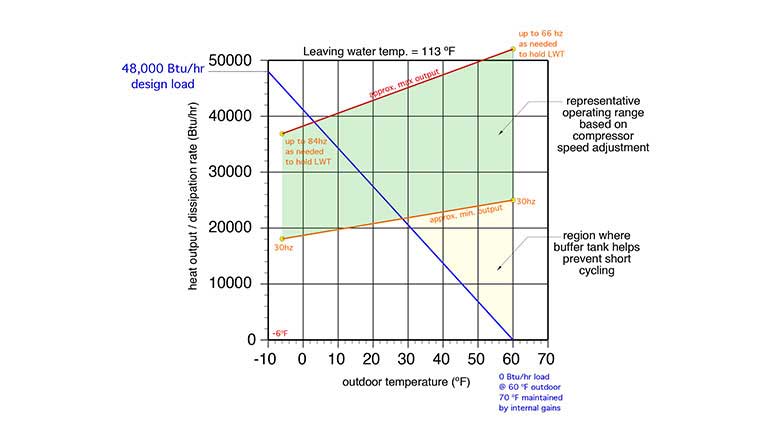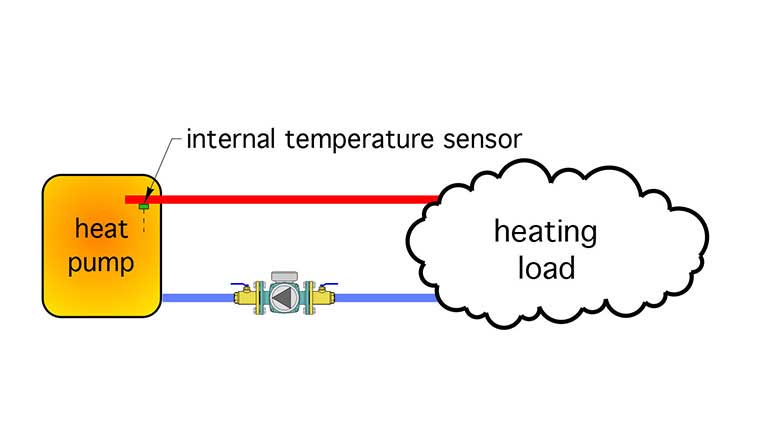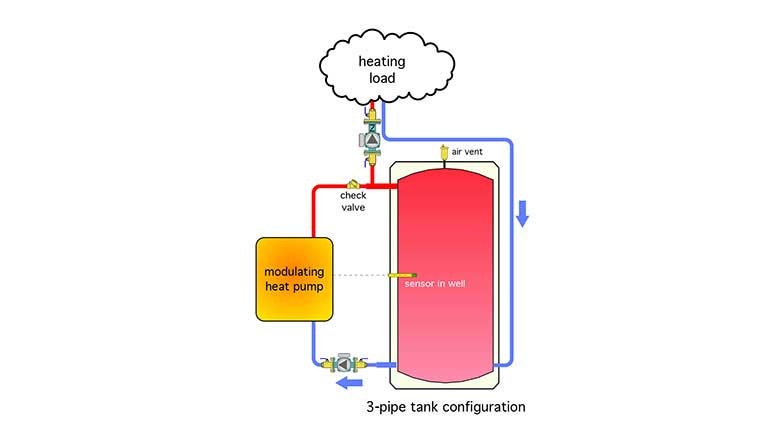John Siegenthaler: Eyes for a heat pump — part two
Variable-speed heat pumps allow a better match between the rate of heat production and the rate of heat dissipation by the load.

Last month, we discussed the role of buffer tanks in combination with air-to-water and water-to-water heat pumps that operate as “on/off” devices. The buffer tank allows the heat pump to operate with reasonably long cycles (e.g., it prevents short cycling) when the hydronic distribution system is heavily zoned, and thus subject to “micro-loading” at times. We also discussed how some buffer tanks can do double duty as both buffers for space heating loads and domestic water heaters. The key concept was to turn the heat pump on and off based on changes in the buffer tank temperatures and not based on thermostats calling for heat.
What about “inverter” heat pumps?
Just as modulating brought variable heat output to gas-fired boilers, air-to-water heat pumps and water-to-water heat pumps are now available with “inverter” driven (e.g., variable speed) compressors that provide a range of heat output from some maximum rated value down to approximately 35% and 40% of that rated value. They also modulate to maintain a set chilled water temperature when operating in cooling mode.
Variable-speed heat pumps allow a better match between the rate of heat production and the rate of heat dissipation by the load. Figure 1 shows an example based on an air-to-water heat pump with a nominal output rating of 4 tons (48,000Btu/h) supplying a building with a design heating load of 48,000 Btu/h at a corresponding outdoor temperature of -10° F.
 FIGURE 1
FIGURE 1
At its maximum allowed compressor speed this heat pump matches the heating load when the outdoor temperature is approximately 3° F. At lower outdoor temperatures, some type of supplemental heat would be needed since the heat pump’s output is less than the load.
At the minimum allowed compressor speed of 30 hz, the heat pump matches the load at an outdoor temperature of about 28° F. At outdoor temperatures between 3° and 28° F, and, in this case, assuming the heat pump maintains a fixed leaving water temperature of 113° F, the compressor speed should be able to adjust output to match the heating load.
Most variable speed heat pumps have a sensor that measures the water temperature leaving the heat pump whenever it’s operating. The heat pump’s internal control algorithm adjusts the compressor speed in an attempt to maintain a specified leaving (a.k.a., “target” temperature) water temperature whenever the compressor is operating. Some heat pumps can also base this target temperature on outdoor reset control.
When a variable speed heat pump is connected directly to the distribution system, as shown in Figure 2, the outlet temperature sensor provides feedback to the internal controls that regulate compressor speed to maintain the target supply water temperature.
 FIGURE 2
FIGURE 2
When there’s a disconnect
When a variable speed heat pump is used in a system that has a buffer tank, hydraulic separator or closely-spaced tees between the heat pump and the load, the temperature reaching the load is not necessarily the same as the temperature leaving the heat pump. Mixing can occur within a buffer tank, hydraulic separator or closely-spaced tees whenever the flow rate through the distribution system differs from that through the heat pump.
If the distribution flow rate is higher, the water temperature reaching the load will be lower than the heat pump’s leaving water temperature due to mixing. If the heat pump flow rate is higher, the water temperature returning to the heat pump increases. The latter is undesirable from the standpoint of heat pump efficiency.
In my opinion, the ideal solution for this situation is a heat pump with a tank sensor that can be installed in a well at the mid-height of the tank, as shown in Figure 3.
 FIGURE 3
FIGURE 3
The temperature at this sensor is a “proxy” for the heating load. When the load is small, such as through a single small panel radiator or towel warmer, the flow rate to the load will also be small. When the heat pump is off, all this flow will come from the buffer tank. The temperature of the tank slowly drops as heat is extracted. Assuming the small load persists, the heat pump will eventually start up at a low speed. If the load is very small, the heat pump may not be able to modulate compressor speed low enough to match it. The difference between the heat production rate and heat dissipation rate will go into the tank. The temperature at the sensor will eventually increase to a point where the heat pump will turn off. Assuming the small load persists, this cycle will repeat itself.
As the load increases, it may reach a point where all the flow from the heat pump is going to the load. The compressor speed adjusts to match the load. Under this condition, the temperature at the sensor will be relatively stable and the heat pump compressor speed should also be stable.
If the flow rate going to the load is high (e.g., think design load conditions), it may exceed the flow rate through the heat pump. The difference between the load flow and heat pump flow would come from the tank, this will cause the temperature at the sensor to slowly drop and signal the heat pump compressor to increase speed.
When there is no load the heat pump would only operate to maintain a target temperature in the buffer tank.
Keep in mind that a typical heat pump flow rate of 2-3 gpm per ton (12,000 Btu/h) of heat output will likely “mix” the tank fairly well. There won’t be much temperature stratification from top to bottom when the heat pump is running.
This strategy can also be used for the domestic water heating function described in last month’s column.
When considering different air-to-water or water-to-water heat pumps for use in a system based on Figure 3, ask about the ability to operate the heat pump based on a buffer tank temperature sensor rather than a temperature sensor inside the heat pump. If the heat pump selected for a project doesn’t have this ability, an external temperature setpoint or outdoor reset controller can be used. The compromise is that most of the current generation setpoint and outdoor reset controllers only provide an on/off signal to the heat sources, and as such don’t allow it to take full advantage of compressor speed modulation.
Perhaps the market will provide a solution in terms of heat pumps that can accept a modulating speed control signal such as 2-10 VDC, 4-20 ma or PWM (pulse width modulation), combined with a controller that can monitor the supply water temperature and output this type of signal to the heat pump. I, for one, would welcome that solution.
Looking for a reprint of this article?
From high-res PDFs to custom plaques, order your copy today!









